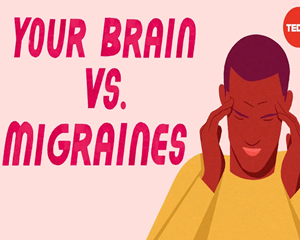A throbbing, pounding headache. Bright zigzagging lines across your field of vision.
抽痛的、剧烈的头痛。明亮的之字形线条划过你的视野。
Sensitivity to light, lingering fatigue, disrupted sleep. A migraine can include any of these symptoms.
对光敏感、疲劳感挥之不去、睡眠出现障碍。偏头痛可能包括上述任何症状。
While an incapacitating headache is one of the most common experiences of migraine,
虽说令人虚弱无力的头痛是偏头痛最常见的体验之一,
the word "headache" doesn't really capture the wide array of experiences a migraine can entail.
但“头痛”这一词并不能真正概括偏头痛可能带来的各式体验。
No two are alike, and some don't even involve a headache. So what then is a migraine? What's happening in the brain to cause it?
没有哪两种是相同的,有些甚至不涉及头痛。那么偏头痛究竟是什么?大脑中发生了什么导致了偏头痛?
To trace a migraine's anatomy, we have to begin in the days and hours leading up to a migraine,
要想追踪偏头痛的解剖学原理,我们必须回溯到偏头痛发作前的几天或几小时,
when people often identify warning signs ranging from fatigue or mood changes, to bursts of yawning, sleep disruption, nausea, light and sound sensitivity, or even increased thirst.
此时人们常常能辨别出预警信号,从疲劳、情绪变化,到一阵阵打哈欠、睡眠紊乱、恶心、对光和声音敏感,甚至口渴加剧。
These warning signs point to a particular part of the brain: the hypothalamus.
这些预警信号都指向了大脑中的某个特定区域:下丘脑。
The hypothalamus normally controls the systems behind these symptoms -- our body's internal hormonal balances, circadian rhythms and water regulation.
下丘脑通常控制这些症状背后的系统--我们身体的内部激素平衡、昼夜节律和水调节。
It has wide connections throughout the brain, and is more active than usual in the days before migraine.
它和整个大脑各个区域都有广泛的连接,在偏头痛发作前几天下丘脑比平常更为活跃。
Another common warning sign is the migraine aura, which can take the form of transient visual changes, tingling, or even trouble speaking.
另一个常见的预警信号是偏头痛先兆,它可以是短暂的视觉变化、刺痛感,甚至言语困难。
These sensations come from a change in charge across cell membranes that leads to spreading changes in brain activity and blood flow across the brain.
这些感觉来源于细胞膜电位的变化,导致脑活动和血流的变化在大脑中扩散。
We don't know what triggers this change in charge,
我们不知道是什么触发了电位变化,
but it can spread quickly over the surface of the brain, causing different aura symptoms depending on the affected area.
但它能快速在大脑表面传播,根据影响区域的不同,引起不同先兆症状。
If it inches over the visual cortex, for example, it may cause an image or blind spot to spread over the visual field.
例如,如果它侵入了视觉皮层,它就有可能导致图像或盲点在视野内扩散。
During the headache phase, the trigeminal nerve plays a key role.
在头痛阶段,三叉神经起到了关键作用。

The trigeminal nerve normally transmits touch, temperature, and other sensations from the skin to most of the face, part of the scalp, and some of the blood vessels and layers covering the cerebral cortex.
三叉神经一般会传递来自大部分脸部皮肤、部分头皮、以及覆盖大脑皮层的一些血管和膜层的触觉、温度和其它感觉。
Once activated, the trigeminal nerve transmits pain signals.
一旦被激活,三叉神经会传递痛觉信号。
During a migraine, this pain pathway becomes sensitized, meaning the threshold for provoking pain is lowered.
当偏头痛发作时,这个痛觉通路会变得敏感化,意思是能触发痛觉的阈值下降了。
Sensations that would usually be pain-free, such as coughing, bending over, or light and sound, can become painful.
那些平时不会疼痛的感觉,比如咳嗽、弯腰,或者声和光,都有可能变得让人疼痛。
Migraines are as common as they are diverse, affecting as many as 33% of women and 13% of men in their lifetimes.
偏头痛不仅多样,还很常见,多达33%的女性和13%的男性在一生中会受到偏头痛的困扰。
Still, there's much we don't know about them.
尽管如此,我们对偏头痛仍然知之甚少。
We can see that migraine is a neurological disorder affecting multiple parts of the brain -- the brainstem, cerebral hemispheres, and the nerves themselves.
我们知道偏头痛是一种神经系统疾病,影响了大脑的多个部分--脑干、大脑半球,还有神经本身。
But we don't know for sure what exactly triggers each step, why some people get migraines and not others,
但我们并不确切知道每一步究竟是由什么触发的,为什么有的人会患上偏头痛而别人却不会受其所扰,
why so many more women do than men, or why people's migraine patterns sometimes change over their lifetimes.
为什么女性患者比男性多了这么多,为什么患者的偏头痛模式有时会随着年龄增长发生变化。
Hormonal fluctuations are thought to have a role in some of these things:
激素水平波动被认为与其中一些问题有关:
some women experience a significant reduction in migraine frequency after menopause, when sex hormone fluctuations are fewer.
更年期之后,性激素的波动减少,有些女性的偏头痛频率也会大幅下降。
Meanwhile, just before menopause, these fluctuations increase, and some women experience worsening or new headaches.
同时,在更年期之前,这些激素波动会增加,有些女性的头痛症状会加重,或出现新的头痛。
People with migraines are more likely to suffer from depression, panic disorder, sleep disorders, and strokes, among other illnesses.
有偏头痛的人更有可能患上抑郁症、恐慌症、睡眠障碍、中风等疾病。
The relationship with these diseases is likely complex, possibly reflecting the effect of migraine on those diseases or vice versa, or reflecting their shared genetic basis.
偏头痛与这些疾病的关系可能很复杂,或许反映了偏头痛对这些疾病的影响,反之亦然;或者反映了它们共同的遗传基础。
Genetics almost certainly play a role, although with a few exceptions, there's no single gene that causes migraines.
虽然存在少数例外,遗传几乎肯定起了一定作用,导致偏头痛的并不是单一的基因。
Certain genes control how easily our brains' neurons are excited by environmental stimuli and how readily they transmit painful signals.
有些基因能控制我们大脑的神经元有多容易被环境刺激激活、能多轻易地传递痛觉信号。
It's possible that the neurons in the brains of people who experience migraines are more easily triggered by environmental stimuli and less likely to block painful signals.
患有偏头痛的人脑中的神经元可能更容易被环境刺激激发,且更不容易阻断痛觉信号。
While there's no simple way to explain what happens in our brains with this complex disorder, one thing is for sure: migraine is much more than a headache.
虽然没有简单的办法可以解释这个复杂的疾病让我们大脑里发生了什么,但有一点是肯定的:偏头痛远远不只是头痛。













